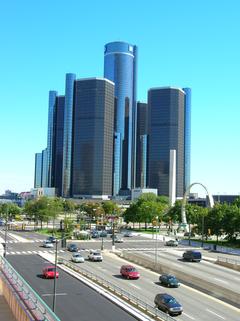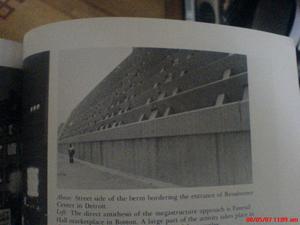tecznotes
Michal Migurski's notebook, listening post, and soapbox. Subscribe to ![]() this blog.
Check out the rest of my site as well.
this blog.
Check out the rest of my site as well.
Aug 5, 2007 7:04pm
blog all dog-eared pages: the social life of small urban spaces
The Social Life of Small Urban Spaces is a brief book on urban plaza design from William Whyte, author of The Organization Man. Here, Whyte focuses on behavior in urban plazas of the sort generally found at the foot of corporate skyscrapers in New York, San Francisco, and other major cities. Various building ordinances and rules require that developers include such plazas in their design, but they are wind-blown and vacant as often as not. This book is the summary of an ethnographic study of these spaces, based on extensive filming of use patterns in 1980.
As with Organization Man, Whyte is a sharp observer and pithy commentator.
Social Life focuses on several topics in turn: crowds (and why people like them), sitting space, fountains, bums, food vendors, and filming techniques for study. The book argues that architects and developers imbue their developments with an emotional tenor that people instinctively pick up on, and shows how it affects use and health. There's a lot here that's directly applicable to social systems on the web, such as passages on distrustful design and "megastructures", the car-focused, inward-facing malls and complexes popular in cities over the past few decades. Whyte isn't optimistic about their future, and I think there are lessons to be learned by inward-facing online destinations such as Facebook.
In the same vein, Wired editor Chris Anderson recently gave up on Second Life because "if you're going to evoke real world conceits such as "places" that you "go to", then you've got to deal with real world expectations of those places. We don't like like empty buildings in RL; why should be more tolerant of them in SL just because there are traces of those who have been there before?"
Overall, Whyte's focus on describing use shows how optimistic architectural renderings break down in the face of natural human use patterns. I especially enjoyed the contrast between Whyte's choice of images for an example megastructure, the Detroit Renaissance Center. Here's an image typical of Google's image results for the center:
Here's Whyte's street-level view:
Bleak.
It's a hopeful book, though - no problem seems insurmountable in the face of realistic expectations and a hot dog stand or two.
Page 19, on crowds:
What attracts people most, it would appear, is other people. If I belabor the point, it is because many urban spaces are being designed as though the opposite were true, and that what people liked best were the places they stay away from. People often do talk along such lines; this is why their responses to questionnaires can be so misleading. How many people would say they like to sit in the middle of a crowd? Instead, they speak of getting away from it all, and use words like "escape", "oasis", "retreat". What people do, however, reveals a different priority.
Page 23, on similarity:
The strongest similarities are found among the world's largest cities. People in them tend to behave more like their counterparts in other world cities than like fellow nationals in smaller cities. Big-city people walk faster, for one thing, and they self-congest. ... Modest conclusion: given the basic elements of a center city - such as high pedestrian volumes, and concentrations and mixtures of activities - people in one place tend to act much like people in another.
Page 33, on benches:
Benches are artifacts the purpose of which is to punctuate architectural photographs. They're not so good for sitting. There are too few of them; they are too small; they are often isolated from other benches or from whatever action there is on the plaza. Worse yet, architects tend to repeat the same module in plaza after plaza, unaware that it didn't work very well in the first place.
Page 35, on chairs:
The possibility of choice is as important as the exercise of it. If you know you can move if you want to, you feel more comfortable staying put. This is why, perhaps, people so often move a chair a few inches this way and that before sitting in it, with the chair ending up about where it was in the first place. The moves are functional, however. They are a declaration of autonomy, to oneself, and rather satisfying.
Page 61, on distrust and "undesirables":
Many corporation executives who make the key decisions about the city have surprisingly little acquaintance with the life of its streets and open spaces. ... To them, the unknown city is a place of danger. If their building has a plaza, it is likely to be a defensive one that they will rarely use themselves. Few others will either. Places designed with distrust get what they were looking for and it is in them, ironically, that you will most likely find a wino.
Page 64, on guards and plaza mayors:
...it is characteristic of well-used places to have a "mayor". He may be a building guard, a newsstand operator, or a food vendor. Watch him, and you'll notice people checking in during the day. ... One of the best mayors I've seen is Joe Hardy of the Exxon Building. He is an actor, as well as the building guard, and was originally hired by Rockefeller Center Inc. to play Santa Claus, whom he resembles. Ordinarily, guards are not supposed to initiate conversations, but Joe Hardy is gregarious and curious and has a nice sense of situations. ... Joe is quite tolerant of winos and odd people, as long as they don't bother anybody. He is very quick to spot real trouble, however.
Page 85, on megastructures:
The ultimate development in the flight from the street is the urban fortress. In the form of megastructures more and more of these things are being put up - huge, multipurpose complexes combining offices, hotels, and shops - such as Detroit's Renaissance Center, Atlanta's Omni International. Their distinguishing characteristic is self-containment. While they are supposed to be the salvation of downtown, they are often some distance from the center of downtown, and in any event tend to be quite independent of their surroundings, which are most usually parking lots. The megastructures are wholly internalized environments, with their own life-support systems. Their enclosing walls are blank, windowless, and to the street they turn an almost solid face of concrete or brick.
Page 89, on the inevitable decline of megastructures:
And it is going to date very badly. Forms of transportation and their attendant cultures have historically produced their most elaborate manifestations just after they have entered the period of their obsolescence. So it may be with megastructures and the freeway era that bred them. They are the last convulsive embodiment of a time passing, and they are a wretched model for the future of the city.
Appendix A is a guide to using film in research.
Page 103, on research fatigue:
But, thanks to the long term time span of our study, we got our second wind and finally learned a few simple but important lessons. The crux is evaluation. Taking the film is easy. So is showing it. It's even fun. But when you start figuring out, frame by frame, what the film has to tell, and what it means, you will find the process can be enormously time consuming, and before long, tedious. That's where it all breaks down. Unless you master this phase, you will not stay the course. Happily, there are ways to shortcut the tedium, greatly speed up evaluation, and in the process make it more accurate.
Page 109, on being careful:
The real danger comes in photographing illicit activities, especially when you do it without realizing it. Our narrowest call was when we set up a perch on the fourth floor of a building in the middle of a block on 101st Street. The object was to observe the social life on the stoops and fire escapes. Before long, Cadillacs with out-of-state license plates began stopping in front of the building opposite, and there was considerable movement in and out of the basement door. A wholesale heroin operation was under way. ... At length it was discerned that a look-out with binoculars was alerting people to the impending arrival of police cars. The, one day, we saw on the film that the binoculars were trained directly on our camera. We withdrew.



Comments
Sorry, no new comments on old posts.